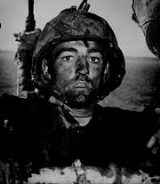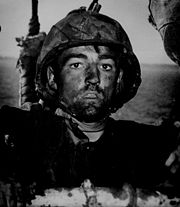
Thousand-yard stare
Encyclopedia

Warrior
A warrior is a person skilled in combat or warfare, especially within the context of a tribal or clan-based society that recognizes a separate warrior class.-Warrior classes in tribal culture:...
. The stare/gaze is a characteristic of acute stress reaction
Acute stress reaction
Acute stress reaction is a psychological condition arising in response to a terrifying or traumatic event...
, also known as combat stress reaction
Combat stress reaction
Combat stress reaction , in the past commonly known as shell shock or battle fatigue, is a range of behaviours resulting from the stress of battle which decrease the combatant's fighting efficiency. The most common symptoms are fatigue, slower reaction times, indecision, disconnection from one's...
, which is related to post-traumatic stress disorder
Post-traumatic stress disorder
Posttraumaticstress disorder is a severe anxiety disorder that can develop after exposure to any event that results in psychological trauma. This event may involve the threat of death to oneself or to someone else, or to one's own or someone else's physical, sexual, or psychological integrity,...
.
The despondent stare is a symptom displayed by victims who have succumbed to the shock of trauma by dissociating
Dissociation
Dissociation is an altered state of consciousness characterized by partial or complete disruption of the normal integration of a person’s normal conscious or psychological functioning. Dissociation is most commonly experienced as a subjective perception of one's consciousness being detached from...
from it. The phrase originated from military circumstances, but it is a symptom of severe psychological distress that can occur anywhere and is not unique to soldiers or settings of warfare.
Etymology
The phrase was popularized when, in 1945, Life magazineLife (magazine)
Life generally refers to three American magazines:*A humor and general interest magazine published from 1883 to 1936. Time founder Henry Luce bought the magazine in 1936 solely so that he could acquire the rights to its name....
published the painting Marines Call It That 2,000 Yard Stare, by World War II
World War II
World War II, or the Second World War , was a global conflict lasting from 1939 to 1945, involving most of the world's nations—including all of the great powers—eventually forming two opposing military alliances: the Allies and the Axis...
artist and correspondent Tom Lea
Thomas C. Lea, III
Thomas Calloway "Tom" Lea, III was a noted American muralist, illustrator, artist, war correspondent, novelist, and historian....
, although the painting was not referred to with that title in the magazine article. The painting was a portrait of a Marine at the Battle of Peleliu
Battle of Peleliu
The Battle of Peleliu, codenamed Operation Stalemate II, was fought between the United States and the Empire of Japan in the Pacific Theater of World War II, from September–November 1944 on the island of Peleliu, present-day Palau. U.S...
in 1944 and is now held by United States Army Center of Military History, Fort Lesley J. McNair, Washington, D.C. About the real-life Marine who was his subject, Lea said:
When recounting his arrival in Vietnam in 1965, then Corporal Joe Houle said he saw no emotion in the eyes of his new squad: "The look in their eyes was like the life was sucked out of them." Later learning that the term for their condition was the 1,000-yard stare, Houle said, "After I lost my first friend, I felt it was best to be detached."

